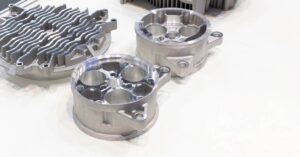Die casting has long been hailed as an efficient and versatile manufacturing process, used extensively to produce intricate metal parts for numerous industries. Yet, despite its widespread popularity and proven results, it’s not without its challenges.
With our experience in the industry, you can be sure that we have solutions in place to overcome these issues. However, we’ll give you some insight so you can get a better understanding.
1. Pore Formation & Gas Trapping
One of the most common challenges in die casting is the formation of pores or the trapping of gases. This happens when molten metal traps the air as it fills the mold, resulting in defects once the metal cools and solidifies.
Solutions
- Venting – Proper placement of vents can allow trapped air to escape as the metal fills the die. Regular maintenance ensures these vents remain clear and effective.
- Fill Time Control – Adjusting the speed at which the molten metal is introduced to the mold can minimize air entrapment. A slow initial fill, followed by a faster fill, can yield better results.
2. Thermal Imbalances
Maintaining the proper temperature is crucial in die casting. A thermal imbalance, either too hot or too cold, can lead to numerous complications, such as cold shuts, warping, or an incomplete fill.
Solutions
- Mold Temperature Control – Utilize mold thermocouples and heaters to actively monitor and adjust mold temperatures.
- Uniform Heating – Implementing a furnace that offers uniform heating of the metal ensures consistency during the casting process.
3. Wear and Tear of Dies
Over time, repetitive casting wears down the dies, reducing precision and potential defects in the finished products.
Solutions
- Regular inspection – Routine checks for signs of wear, erosion, or damage ensure longevity of the die.
- Use of lubricants – Applying lubricants ensures a smooth release of the finished product and reduces friction, minimizing wear and tear.
4. Shrinkage & Inconsistencies
As molten metal cools, it contracts. If not managed properly, this can result in parts that have inconsistencies, like uneven surfaces or internal voids.
Solutions
- Mold design – Incorporating features in the mold design that promote even cooling can mitigate shrinkage issues.
- Material selection – Different alloys have different shrinkage rates. Selecting the right material based on the product’s requirements can make a significant difference.
5. Flash and Excessive Material
Flash refers to thin pieces of metal that leak out of the mold during the casting process. These unintended protrusions necessitate additional trimming, increasing production time and waste.
Solutions
- Mold maintenance – Ensure that the molds are well-maintained and free of any misalignment or wear, which can result in flash.
- Optimize clamping pressure – Adjusting the clamping pressure can minimize leakage and the resultant flash.
6. Inconsistent Grain Structure
In some cases, the metal may solidify at different rates, leading to an inconsistent grain structure. This can impact the mechanical properties of the final product, making it weaker or more brittle.
Solutions
- Cooling system refinement – Ensuring that the cooling system promotes uniform cooling can help achieve a consistent grain structure.
- Temperature monitoring – Implementing advanced temperature monitoring tools ensures that the metal solidifies at an optimal rate.
7. Limited Complexity in Thin-walled Parts
Producing thin-walled components with intricate designs can be challenging, as the molten metal may not flow and fill the thin sections evenly.
Solutions
- Use of vacuum – Implementing a vacuum assist during casting can help the metal fill more intricate and thin-walled designs.
- High-pressure casting – Adjusting the casting process to a high-pressure method can ensure the even spread of metal in thin sections.
8. Oxidation and Corrosion
The exposure of molten metal to oxygen, even in minute amounts, can lead to oxidation, affecting the part’s finish and overall integrity. Over time, these oxidized parts can also be more susceptible to corrosion.
Solutions
- Protective atmosphere – Introducing a protective gas environment during casting can reduce the chances of oxidation.
- Post-casting treatments – Implementing post-casting processes, such as chromate conversion coatings, can enhance corrosion resistance.
Enhancing Efficiency with Process Improvements
Die casting, like any production process, benefits immensely from continuous improvement. Here are some actionable steps to take:
- Employee training – A skilled workforce can anticipate issues and handle challenges efficiently. Regular training sessions keep the team updated with the latest best practices.
- Invest in quality equipment – Advanced machinery with enhanced controls and precision can reduce errors and streamline the casting process.
- Feedback loop – Implementing a robust feedback system where operators and quality control teams communicate effectively ensures that issues are detected and rectified early.
Conclusion
While die casting is undoubtedly a potent manufacturing method, it’s not devoid of challenges. But with the right strategies, insights, and commitment to continuous improvement, these challenges can be converted into opportunities for excellence. Whether it’s through technological advancements, better materials, or refined processes, the path to producing impeccable die-cast parts is paved with innovation and diligence.
By understanding these challenges and solutions, manufacturers can not only produce high-quality parts but also optimize production, reduce costs, and ensure the longevity of their equipment. As the adage goes, knowledge is power, and in the world of die casting, it’s the key to overcoming obstacles and achieving unparalleled success.






